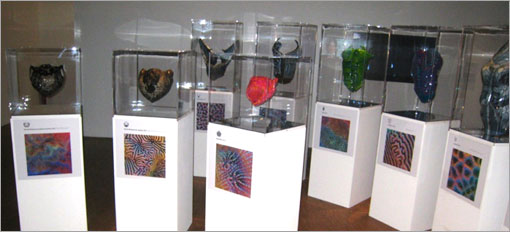A series of exquisite scanning electron micrographs by Wyss research associate James Weaver is now on display at the Pompidou Center in Paris as part of its “Imaginary Beings: Mythologies of the Not Yet” exhibit. In shimmering gold, turquoise, and purple, Weaver’s colorful images illustrate a range of intricate patterns found in the skeletal structures of various species of reef-building corals. The work is part of an ongoing collaboration with Neri Oxman, the Sony Corporation Career Development Professor and Professor of Media Arts and Sciences at the Massachusetts Institute of Technology, in which the two researchers are exploring ways to apply biologically inspired pattern formation to design and architecture.

For each of Weaver’s two-dimensional images in the display, Oxman has created a three-dimensional design. She used a digital manufacturing process, called 3D printing, in which solid objects are built from successive layers of material to craft bold-colored structures out of robust UV-curable polymers. Based on algorithms inspired from the unique patterns in each micrograph, her art works highlight the complex and diverse architectures encountered in biological systems. Together Weaver’s micrographs and Oxman’s 3D designs afford complementary views of nature’s aesthetic.
The exhibit runs through August 6, 2012, at the Pompidou Center, a multicultural complex in the heart of Paris that houses Europe’s leading collection of modern and contemporary art, as well as a vast public library, a music research institute, and cinema and performance halls. “Imaginary Beings: Mythologies of the Not Yet” explores the concept that futuristic design can be rooted in ancient myth.
Many mythological figures, for instance, have been portrayed as personifications of natural forces. In revealing nature’s design language, Oxman’s collection suggests that these historical personifications can be brought to life in designs made possible by technological advances, such as novel multi-material 3D printing.

The exhibit runs through August 6, 2012, at the Pompidou Center, a multicultural complex in the heart of Paris that houses Europe’s leading collection of modern and contemporary art, as well as a vast public library, a music research institute, and cinema and performance halls. “Imaginary Beings: Mythologies of the Not Yet” explores the concept that futuristic design can be rooted in ancient myth.
Many mythological figures, for instance, have been portrayed as personifications of natural forces. In revealing nature’s design language, Oxman’s collection suggests that these historical personifications can be brought to life in designs made possible by technological advances, such as novel multi-material 3D printing.
Oxman is an architect and researcher who turns to the natural world for ingenious ways to create objects and structures that meld harmoniously with their surroundings. The algorithms for the biologically inspired patterns on which her work is based were developed in close collaboration with Craig Carter of the Department of Materials Science and Engineering at MIT and Joe Hicklin at The Mathworks.

With more than 10 years of experience in graphic design, Weaver is a leader in the use of scanning electron microscopy (SEM) to study a wide range biomineralization processes. In SEM, a beam of high-energy electrons is focused on a sample, generating a variety of signals that reveal information about the sample’s texture, elemental composition, and crystal structure. Using the latest advances in high-resolution wide-field SEM available at the Wyss Institute, Weaver worked with cultured specimens from coral farms throughout the tropical Indo-Pacific. The resulting images capture the stunning architectural complexity of these incredibly diverse and ecologically important marine invertebrates. The exhibit is part of the larger “Multiversites Creatives” exhibition in which visitors are led down a path of experimentation, research, and forward-looking work in the fields of architecture, design, new technologies and social innovation.